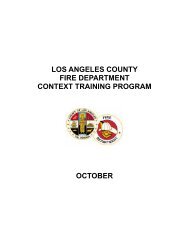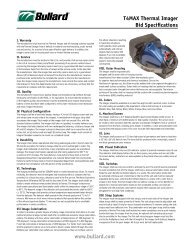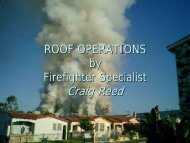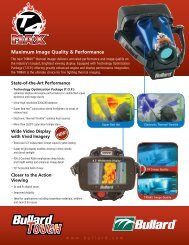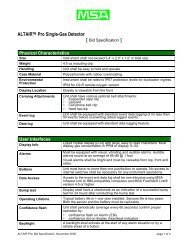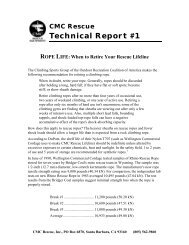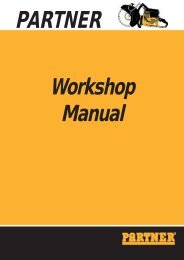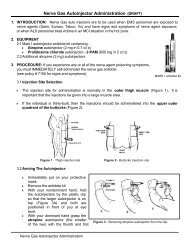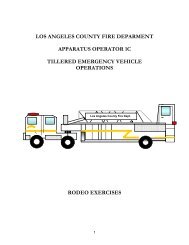PARTNER K950 Operators Manual 1998.pdf
PARTNER K950 Operators Manual 1998.pdf
PARTNER K950 Operators Manual 1998.pdf
You also want an ePaper? Increase the reach of your titles
YUMPU automatically turns print PDFs into web optimized ePapers that Google loves.
!<br />
Over<br />
exposure to vibrations can result in<br />
blood-vessel or nerve injury to persons<br />
suffering with blood circulation problems.<br />
Seek medical attention if you experience<br />
physical symptoms that can be related to over<br />
exposure to vibrations. Examples of such<br />
symptoms are numbness, lack of feeling,<br />
“tickling“, “pricking“, pain lack of or a<br />
reduction in normal strength, changes in the<br />
colour of the skin or its surfaces. These<br />
symptoms normally appear in the fingers,<br />
hands or wrists.<br />
SAFETY INSTRUCTIONS<br />
Water cooling<br />
!<br />
WARNING! Water cooling, which is only used<br />
for petrol-driven power cutters and when<br />
cutting concrete, cools the cutting blade and<br />
increases its service life as well as reduce<br />
dust formation (see the section ”Abrasive<br />
blades”). Among the disadvantages are<br />
difficulties at very low temperatures, the risk<br />
of damaging the floor and other sections of<br />
the building and risk for slippage.<br />
Cutting technique<br />
The technique described below is of a general character. Check<br />
information for each blade regarding individual cutting characteristics.<br />
(For example, a diamond blade requires less feeding<br />
pressure than a abrasive blade).<br />
1.Support the work piece<br />
in such away that you<br />
can predict what will<br />
happen and so it will not<br />
pinch.<br />
2.Always cut at full throttle.<br />
3.Start cutting gently, do<br />
not force or squeeze the<br />
blade in.<br />
4.Use a high blade speed.<br />
5.Move the blade slowly<br />
backwards and forwards.<br />
6.Use a small part of the<br />
blade’s cutting edge.<br />
7.Only use the blade’s<br />
cutting edge when<br />
cutting.<br />
8.Cut with the blade fully<br />
vertical – at right angles<br />
to the work piece.<br />
Sharpening diamond blades<br />
Blades can become dull when the wrong feeding pressure is<br />
used or when cutting some materials such as heavily reinforced<br />
concrete. To force a dull blade results in overheating and finally<br />
the loss of segments (part of the blade).<br />
Sharpen against a soft material such as sandstone, silica or<br />
haydite brick.<br />
Blade vibration<br />
The blade can become out of shape (not round) and vibrate if a<br />
too high feeding pressure is used or if the blade is pressed into<br />
the work piece.<br />
A lower feeding pressure ought to stop the vibration. Otherwise<br />
replace the cutting blade.<br />
Kickback<br />
Kickback can occur very suddenly and with great force. If the<br />
following directives are not followed, it can result in serious or<br />
even fatal injury.<br />
If the sector of the blade illustrated below is used for cutting the<br />
blade can start to climbing and kickback the power cutter<br />
upwards and backwards towards the user with immense force.<br />
How to avoid kickback<br />
1.Never cut with the<br />
segment illustrated in the<br />
diagram.<br />
2.Keep a good balance and<br />
a firm foothold.<br />
!<br />
!<br />
WARNING!<br />
Under all circumstances avoid cutting using<br />
the side of the blade; it will almost certainly<br />
be damaged, break and can cause immense<br />
damage. Only use the cutting section.<br />
WARNING!<br />
Do not lean the blade to the side, this can<br />
cause the blade to jam or break with personal<br />
injury as a consequence.<br />
3.Use both hands and take<br />
a firm grip with the thumb<br />
and fingers around the<br />
handle.<br />
4.Keep the work piece at a<br />
comfortable distance.<br />
5.Use the cutter at full<br />
throttle.<br />
6.Take care when inserting<br />
the blade in an existing<br />
cut.<br />
7.Never cut above shoulder<br />
height.<br />
8.Be alert to movement of<br />
the work piece or anything<br />
else that can occur, which<br />
could cause the cut to<br />
close and pinch the blade.<br />
8 – English



